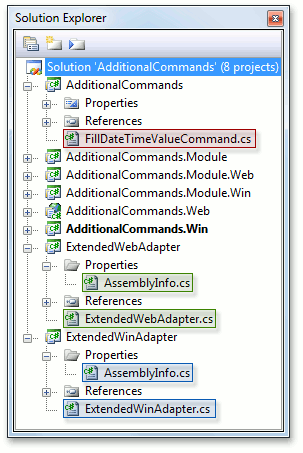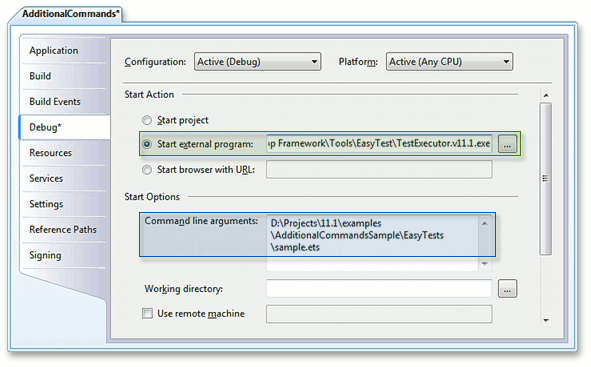How to: Implement a Custom EasyTest Command
- 6 minutes to read
EasyTest functional testing framework provides a set of predefined commands that cover most of the common use cases. To support specific scenarios, you can implement custom commands. This topic describes the implementation of custom FillDateTimeValue command that is capable of specifying a DateTime value relative to the current date. You can use this command in tests when the application behavior depends on the current date.
Note
Mobile applications do not support the EasyTest functional testing.
Tip
A complete sample project is available in the DevExpress Code Examples database at https://supportcenter.devexpress.com/ticket/details/e3018/how-to-implement-a-custom-easytest-command.
Inherit the Command Class
To implement a custom EasyTest command, inherit the Command abstract class from the DevExpress.EasyTest.Framework namespace. It is recommended that you implement this class in a separate Class Library project of your XAF solution, so it will be built into a separate assembly that can be reused in other XAF applications. Override the Command.InternalExecute virtual method and implement the command logics in it. Use the base class’ Command.Parameters property to access command’s parameters. Instantiate the CommandException class to handle an error. The ICommandAdapter.CreateTestControl method exposed by the adapter parameter finds control by its caption and wraps it around an ITestControl interface. To communicate with the control, use the ITestControl.GetInterface<T> method. The following snippet illustrates the FillDateTimeValueCommand command implementation.
using System.Globalization;
using DevExpress.EasyTest.Framework;
// ...
public class FillDateTimeValueCommand : Command {
private int GetIntegerParameterValue(string parameterName) {
int result = 0;
Parameter parameter = Parameters[parameterName];
if (parameter != null)
{
if(!Int32.TryParse(parameter.Value, out result)) {
throw new CommandException(string.Format(
"'{0}' value is incorrect", parameterName), this.StartPosition);
}
}
return result;
}
protected override void InternalExecute(ICommandAdapter adapter) {
int deltaDays = GetIntegerParameterValue("Days");
int deltaHours = GetIntegerParameterValue("Hours");
int deltaMinutes = GetIntegerParameterValue("Minutes");
string cultureName = Parameters["Culture"] != null ? Parameters["Culture"].Value : null;
CultureInfo currentCulture =
cultureName != null ? CultureInfo.GetCultureInfo(cultureName) : null;
string fieldName = Parameters.MainParameter.Value;
ITestControl testControl = adapter.CreateTestControl(TestControlType.Field, fieldName);
DateTime dateTime = DateTime.Now.Add(new TimeSpan(deltaDays, deltaHours, deltaMinutes, 0));
string dateTimeValue = currentCulture != null ?
dateTime.ToString(currentCulture) : dateTime.ToString();
testControl.GetInterface<IControlText>().Text = dateTimeValue;
}
}
This command’s primary parameter specifies a field caption to be filled. It also takes the Days, Hours and Minutes extra parameters that specify the differences between the time to be specified and the current time. The Culture extra parameter is intended for overcoming any localization-specific issues.
Note that the IControlText interface is passed as the GetInterface<T> method’s generic parameter. It means that the command’s target control provides an editable text. Other supported interfaces are listed in the ITestControl topic.
Register the Custom Command
The WinAdapter and WebAdapter classes are responsible for running the application when testing. In this example we will override the default WinAdapter and WebAdapter classes. This should be done in separate Class Library projects. These classes are very simple and contain overridden WinAdapter.RegisterCommands methods.
ExtendedWinAdapter Class:
using DevExpress.ExpressApp.EasyTest.WinAdapter;
using DevExpress.EasyTest.Framework;
using AdditionalCommands;
namespace ExtendedAdapters {
public class ExtendedWinAdapter : WinAdapter {
public override void RegisterCommands(IRegisterCommand registrator) {
base.RegisterCommands(registrator);
registrator.RegisterCommand("FillDateTimeValue", typeof(FillDateTimeValueCommand));
}
}
}
In the same Class Library project, open the AssemblyInfo.cs (AssemblyInfo.vb) file and register the adapter.
[assembly: DevExpress.EasyTest.Framework.Adapter(typeof(ExtendedAdapters.ExtendedWebAdapter))]
ExtendedWebAdapter Class:
using DevExpress.ExpressApp.EasyTest.WebAdapter;
using DevExpress.EasyTest.Framework;
using AdditionalCommands;
namespace ExtendedAdapters {
public class ExtendedWebAdapter : WebAdapter {
public override void RegisterCommands(IRegisterCommand registrator) {
base.RegisterCommands(registrator);
registrator.RegisterCommand("FillDateTimeValue", typeof(FillDateTimeValueCommand));
ScriptParser scriptParser = ((ScriptParser)registrator);
}
}
}
In the same Class Library project, open the AssemblyInfo.cs (AssemblyInfo.vb) file and register the adapter.
[assembly: DevExpress.EasyTest.Framework.Adapter(typeof(ExtendedAdapters.ExtendedWebAdapter))]
The resulting solution structure is illustrated in the image below (new and modified files are highlighted).

Configure EasyTest to use Custom Adapter Classes
In order to use custom Adapter assemblies instead of default ones, the EasyTest configuration file must be modified in the following manner.
<Options>
<!-- ... -->
<Aliases>
<Alias Name="WinAdapterFileName"
Value="[SolutionPath]\ExtendedWinAdapter\bin\EasyTest\ExtendedWinAdapter.dll" />
<Alias Name="WebAdapterFileName"
Value="[SolutionPath]\ExtendedWebAdapter\bin\EasyTest\ExtendedWebAdapter.dll" />
<!-- ... -->
</Aliases>
</Options>
A Sample Script that Uses the FillDateTimeValue Command
To see the FillDateTimeValue command in action, add the Event class from the Business Class Library via the Module Designer. Then, create and run the following EasyTest script.
#DropDB AdditionalCommands
#Application AdditionalCommandsWin
#Application AdditionalCommandsWeb
*Action Navigation(Scheduler Event)
*Action New
*FillDateTimeValue Start Date/Time
Culture = en-US
Days = -1
Hours = 1
*FillDateTimeValue End Date/Time
Culture = en-US
*Action Save
Debug Custom Command
Use the following approach when you need to debug a custom EasyTest command implementation
- Set the Class Library project that contains the FillDateTimeValue command implementation as StartUp.
- Set required breakpoints in the command’s code.
Open project properties and modify the Start external program and Command line arguments options under the Debug tab. The first should point to the TestExecutor utility, the latter - to the script that uses the command.

Now you can set breakpoints in a command’s code and debug.